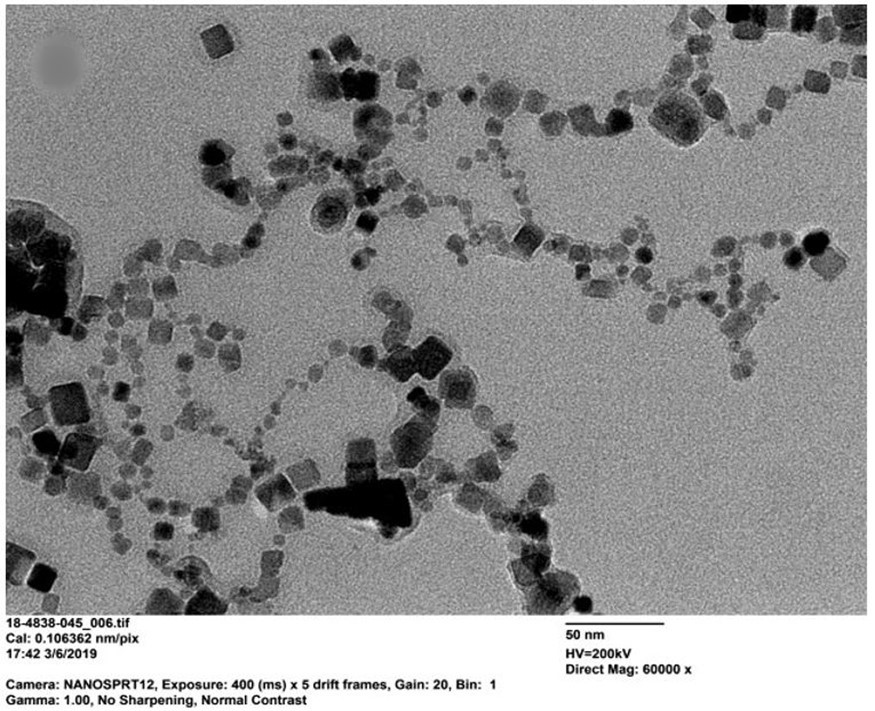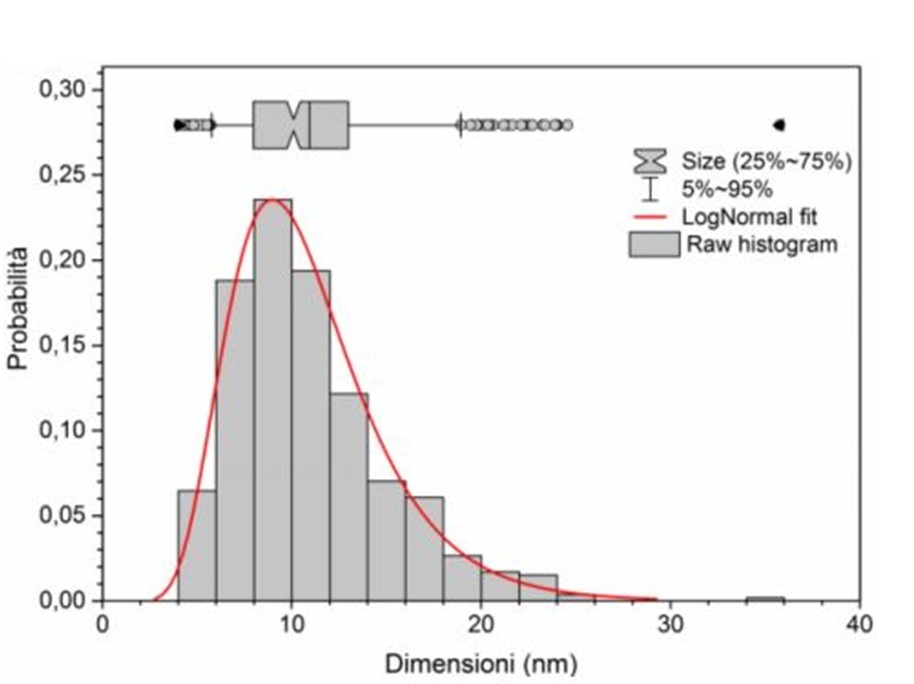Cobalt oxide nanoparticles (Co3O4, spinel) is a mixed-valency oxide that in its nanocrystalline form finds applications as heterogeneous catalyst for a variety of reactions.

We at Particular Materials synthesize cobalt oxide (Co3O4 , spinel) nanoparticles and we can provide tailor-made Co3O4 nanoparticles doping. We produce and supply Co3O4 nanodispersions in water and organic solvent with excellent stability, monodispersity and fully disaggregated state.
- To buy Co3O4 nanoparticles nanopowders and nanodispersions, and for information on pricing, click and request a free quotation now,
- For a Technical Request and for tailor made nanomaterials, don’t hesitate to ask for free support now, click here.
Technical Information
Our Cobalt oxide (Co3O4) nanoparticles portfolio consist of particles with diameters ranging around 14 nanometers and find applications in several industries.
Cobalt oxide nanoparticles (Co3O4) have been studied as apotential candidate for photocatalytic degradation due to its high surface-to-volume ratio, low cost, excellent chemical and physical stability.
As described in more detail below, Co3O4 nanoparticles have outstanding optical, electrical and magnetic properties that can be applied to gas sensing, supercapacitors and lithium ion batteries.
Co3O4 nanoparticles can be exploited as chemisensor and dielectric material. Low particle size, p-type conductivity, dual energy band gap, good crystalline nature, the high value of dielectric constant, low value of dielectric loss, and good AC conductivity demonstrate the potential candidature of Co3O4 nanoparticles as efficient charge carriers in chemical sensors and capacitors.
Co3O4 Cobalt Oxide nanoparticles are used as the anode materials of lithium‐ion batteries. Cobalt oxide nanoparticles, offer high surface-to-volume ratio and short path length for lithium cation transport, leading to high discharge capacity and superior cycling reversibility.
Cobalt oxide particles may be anchored on substrates to improve the dimensional stability of the anode and to prevent particle aggregation during lithium charge and discharge processes.
In order to be able to take advantage of the various properties of Cobalt Oxide (Co3O4) nanoparticles, significant care needs to be taken in controlling size, monodispersity and crystalline structure.
We at Particular Materials synthesize nano Co3O4 and we produce dispersions with excellent stability, monodispersity, crystalline purity and fully disaggregated state.
The Co3O4 nanoparticles are available in one size:
- 14 ± 7.8 nm
Typical concentration in water are, by weight (w/w%):
- 1%
- 5%
- 20%
Co3O4 can also be provided as nanopowder.
- For specific requirements please send a Technical Support Request
- For a Technical Request and for tailor made nanomaterials, don’t hesitate to ask for free support now, click here.
Related Applications and Industries
Other key applications of cobalt oxide nanoparticles are as follows:
- In micro-electronics
- As a magnetic nanoparticles
- In catalysis, superconductors, electronic ceramics
- In temperature and gas sensors
- In electrochromic devices
Co3O4 nanoparticles and nanocrystals and in general catalysts based on cobalt oxides have a great importance for catalytic processes like Fischer–Tropsch synthesis, N2O decomposition, steam reforming of ethanol and other industrially important hydrogenation and oxidation reactions, diesel soot oxidation, and catalytic combustion of volatile organic compounds (VOCs).
For the total oxidation of CO and hydrocarbons, noble metal (such as Au, Pt, Pd, Ru) catalysts supported high surface area oxides exhibit excellent activities, but the high cost and low availability of noble metals limit their commercial application.
High attention has been paid in the last few years to single and binary oxide catalysts in order to substitute noble metals. Although transition metal oxides sometimes exhibit relatively low specific activity, cobalt oxide has been demonstrated to be one of the most efficient catalysts for CO, CH4 and VOC total oxidation and it has the advantages of high activity and low cost compared with noble metal catalysts.
We at Particular Materials can synthesize custom-made Co3O4 catalysts based on your specific needs through our proprietary continous flow hydrothermal synthesis.
A peculiar characteristic of all nanoparticles is the high surface area to volume ratio, that allows a considerably higher binding capacity and excellent dispersibility of NPs in solutions.
Pricing
Selected nanotechnology research articles
Time-resolved observations of water oxidation intermediates on a cobalt oxide nanoparticle catalyst. M. Zhang, M. de Respinis, H. Frei Nature Chemistry volume 6, pages 362–367 (2014).
One-Dimensional Arrays of Co3O4 Nanoparticles: Synthesis, Characterization, and Optical and Electrochemical Properties. X. Wang, X. Chen, L. Gao, et al. The Journal of Physical Chemistry B 2004 108 (42), 16401-16404.
Physical properties, biological applications and biocompatibility studies on biosynthesized single phase cobalt oxide (Co3O4). Arabian Journal of Chemistry, Volume 13, Issue 1, 2020, Pages 606-619. Ali Talha Khalil, et al.
Nanomolar detection of hydrogen peroxide on glassy carbon electrode modified with electrodeposited cobalt oxide nanoparticles. A. Salimi, R. Hallaj, S. Soltanian, H. Mamkhezri, Analytica Chimica Acta, Volume 594, Issue 1, 2007, Pages 24-31.
Graphene Anchored with Co3O4 Nanoparticles as Anode of Lithium Ion Batteries with Enhanced Reversible Capacity and Cyclic Performance. Z.S. Wu, W. Ren, L. Wen, L.Gao, J. Zhao, at al ACS Nano 2010 463 187-3194.
Magnetic properties of Co3O4 nanoparticles. Journal of Magnetism and Magnetic Materials, Volume 246, Issues 1–2, 2002, Pages 184-190. Salah A. Makhlouf
One-Dimensional Arrays of Co3O4 Nanoparticles: Synthesis, Characterization, and Optical and Electrochemical Properties. Xiong Wang, Xiangying Chen, Lisheng Gao, Huagui Zheng, Zude Zhang, and Yitai Qian. 2004
Structural and Optical Properties of Co3O4 Nanoparticles Prepared by Sol-gel Technique for Photocatalytic Application. Int. J. Electrochem. A.B. Vennela, D. Mangalaraj , N. Muthukumarasamy , S. Agilan , K.V. Hemalatha. 2019.
